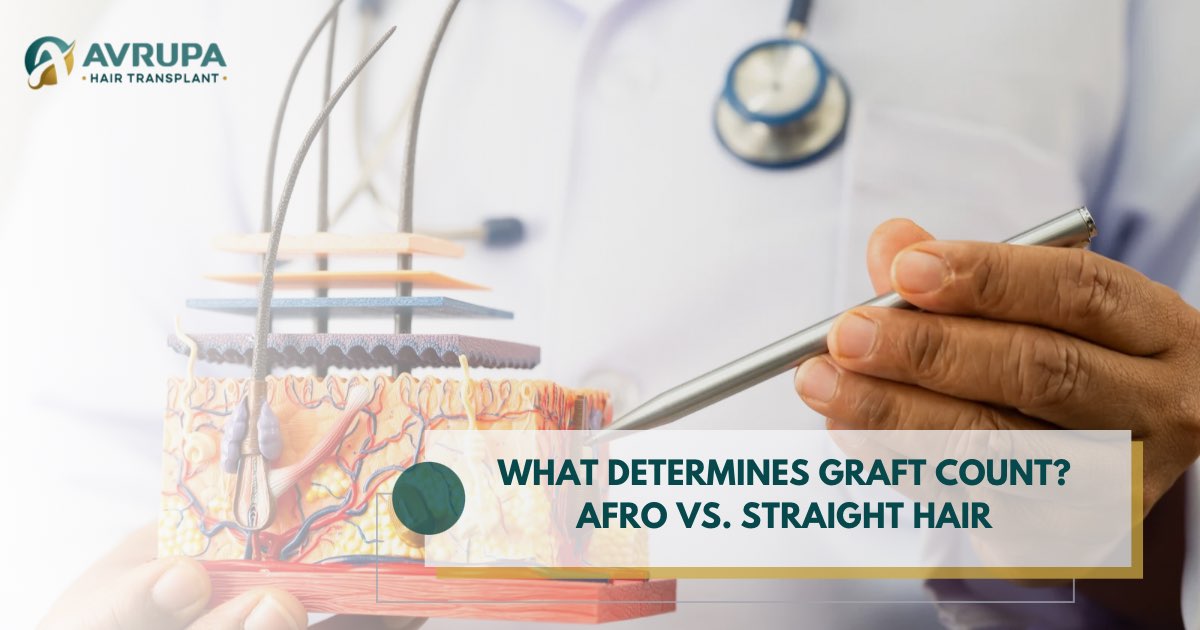
Graft Counts for Afro Hair vs. Straight Hair Transplant

September 16, 2025 by
avrupahairtransplant
“How many grafts do I need?” is the first question most patients ask when they come to our clinic—yet the honest answer is, “It depends on your hair grafts.” Coverage isn’t only about a big number; it’s about how caliber (thickness), curl, color contrast, and follicular-unit makeup translate grafts into the look of fullness. Afro-textured hair (Type 3–4) often achieves more visual density with fewer grafts than straight, fine hair—if planning respects donor limits and the biology of coiled follicles. This guide breaks down the variables that determine graft counts for Afro hair vs. Straight hair transplant and explains why “more grafts” isn’t always better.
The Variables that Determine Your Graft Count: Afro vs. Straight Hair
Determining the graft count for a hair transplant depends on many factors, including:
Native density & follicular-unit (FU) density
Population studies and surgical reviews consistently show ethnic differences. For instance, Caucasian scalps generally have higher average hair/FU densities than African and some Asian scalps, but this is only one piece of the visual-density puzzle.
Caliber (shaft thickness) & curl pattern
Thicker hair and tighter curl throw more shadow and bulk, creating the appearance of higher density at lower graft counts. This is a key advantage for Afro hair. Professional guidance explicitly flags curl/wave as a major contributor to fullness.
Hair-to-skin color contrast
Lower contrast (e.g., dark hair + dark skin) reduces the “see-through” effect, again lowering the grafts needed for a full look. Whereas high contrast does the opposite.
Extraction & survival
FUE on curled follicles is a technique test: curved/non-rotary or flared punches and low-RPM, short-arc motion help follow the follicle path and keep transection rates low—directly preserving graft numbers available to plant.
Afro Hair vs. Straight Hair
While Africans often have lower average native hair density than Caucasians, Afro hair’s curl + geometry deliver stronger coverage per graft, especially in the frontal third. That’s why two patients with the same graft count can look very different.
For similar cosmetic goals in the frontal third, Afro/coily hair may reach targets at ~30–40 grafts/cm², whereas straight/fine hair can require ~50–60 grafts/cm² (or staged work) to avoid a see-through result. These are planning bands, not promises—surgeons individualize based on donor and aesthetics.
Donor Math and Why it Caps Your Plan?
Typical donor FU density often falls in the ~80–100 FU/cm² range in many patients. Your surgeon maps safe zones and calculates an ethical harvest fraction to avoid donor depletion. Safe excision limits depend on baseline FU density and surface area; professional literature emphasizes modelling extraction per cm², so the donor still looks natural short.
Planning an Afro Hair Transplant in Turkey
Getting the graft count right is only one part of the equation. Protecting the donor area and achieving natural density require a team experienced in coiled hair follicles. That’s why our Turkey Afro hair transplant program is designed around these principles, combining precise donor mapping with techniques that respect curl and caliber.
Why “More Grafts” Isn’t Always Better?
Dense-packing beyond ~50–60 grafts/cm² in one pass can jeopardize survival, especially with fine hair and thin dermis. Packing too many grafts at once starves them of blood. When recipient sites are clustered beyond ~50–60 grafts/cm², the tiny “tissue bridges” that carry oxygen are cut down, local pressure and swelling rise, and microcirculation can’t perfuse every graft, so some die.
Dense-packing work also means more trauma and longer out-of-body time (higher risk of drying or popping), especially in fine hair or thin dermis. Staging density lets new vessels grow first (angiogenesis), so the next pass can thrive instead of competing.
Experienced clinics describe this as an upper practical ceiling, not a target for every patient.
Bottom line
Graft numbers aren’t a scoreboard—they’re a design decision. Afro/coily hair often achieves the same visual fullness with fewer grafts thanks to curl and caliber, but your true limit is donor math + extraction quality + future-loss planning. Prioritize the frontal frame, stage density rather than overpacking (>~50–60 grafts/cm²), and keep a reserve for tomorrow. The best results come from a surgeon who measures your FU density, respects curl/contrast and has proven Afro-FUE technique with low transection.
Written By
avrupahairtransplant
Avrupa Hair Transplant Clinic, Istanbul’s trusted name since 2006, transforms hair restoration with cutting-edge techniques like FUE, DHI, and Sapphire, crafting natural, lasting results. With over 40,000 success stories and a collection of international awards, Avrupa blends innovation with artistry, delivering personalized care that redefines confidence for clients worldwide.